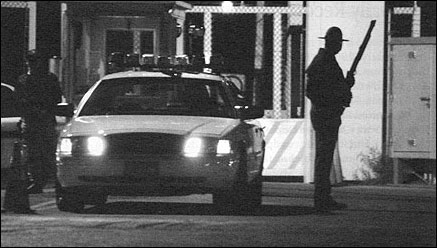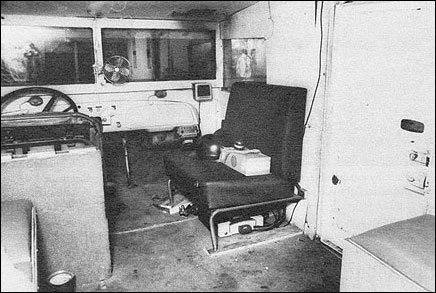
State police stand ready with weapons during a security alert at Three Mile Island. October 2001. Photo by Bil Bowden/York Daily Record/Sunday News.
Shortly before 5:30 p.m. on October 17, 2001, the Nuclear Regulatory Commission (NRC) received word of an immediate threat against Three Mile Island’s (TMI) Unit 1 reactor. An American who controlled the “refrigeration” to the reactor was to attack the plant’s interior while someone else would deliberately crash a plane into the reactor’s containment building.
The NRC received this threat five weeks after the September 11th terrorist attacks and during the height of the anthrax scare. The federal agency took the threat seriously. The government scrambled to get two fighter jets to south central Pennsylvania to patrol the skies over TMI. The agency eventually deemed the threat not credible.
For York County residents, who live in the shadow of TMI, the threat and the fear associated with it was real. The York Daily Record/Sunday News reported that some lawmakers criticized how officials handled the crisis. For example, some local government officials had not been notified about the potential threat that evening. The paper quoted a lawmaker as saying, “They didn’t spell out what it was except it was a threat they were taking seriously.” Understandably, readers wanted to know more, including reassurance that the government and plant operators were prepared if terrorists had indeed picked TMI, site of America’s worst nuclear disaster, as a potential target.

Reporters used the FOIA to obtain records about a possible terrorist threat to Three Mile Island’s nuclear power plant. October 2003. Photo by Paul Kuehnel/York Daily Record.
Shortly after the October threat, the York Daily Record filed a Freedom of Information Act (FOIA) request with the NRC to dislodge documents related to the agency’s response to the threat. More than a year after the paper filed the request, the NRC released a two-paragraph e-mail written by an inspector who complained about the lack of direction when responding to the threat. After the NRC denied the paper’s original request, the Daily Record appealed. The NRC’s executive director for Homeland Protection and Preparedness reviewed the appeal and eventually ruled some documents could be released to the Daily Record because they contained information of legitimate public interest.
It turns out that the NRC withheld about 150 pages of information related to the threat, including a chronology of information and actions, handwritten logs, and lesson-learned reports. The records, released on December 3, 2003, provided a minute-by-minute account revealing that officials believed simultaneous attacks would occur from the air and from a saboteur inside TMI. They also showed the following:
- TMI officials did not learn of the threat until about an hour after the NRC received it.
- The reactor and its radioactive core were more vulnerable on this day because the vessel was being refueled. To allow for that, a massive hatch had been removed from the vessel and the head was off the reactor pressure valve. Workers needed almost three hours to close that hatch.
- Aside from investigating the threat against TMI, federal and state officials contended with other issues, such as airplanes venturing into restricted airspace around the plant and public announcements by outside airports concerning security at the plant.
We published stories based on what we learned from these records. The newspaper used the documents to build stories and graphics to explain what happened behind the scenes that night and to describe lessons officials had learned and what steps the plant and the government would take to better coordinate their response should a similar threat arise. For example, one NRC official noted the difficulty the agency had in reaching the plant’s senior management.
The Newspaper Begins Its Use of FOIA
When this threat to TMI came, the York Daily Record was already well-versed in how to use the FOIA to obtain records that would enable the paper to tell the stories that might otherwise go untold. The Daily Record/Sunday News has a daily circulation of about 48,000 and reaches roughly 93,000 homes on Sunday, and given our wide-ranging experience with FOIA requests, we were in a good position to challenge the government’s blanket denials of information releasable under the FOIA prior to September 11th.
RELATED ARTICLE
“Tips About FOIA Filings”
– Rob WaltersIn 2000, when the York County district attorney’s office convened a grand jury to investigate the 1969 killings of a black woman and white police officer, the paper learned quickly that it needed to pursue a variety of investigative avenues to report this story. Because we operate in a highly competitive two-newspaper town, getting accurate and complete information that we need to report a story is critical. In this case, since the city’s mayor was a suspect in one of the murders, the need to obtain all the facts we could was even more essential.
With the grand jury proceedings cloaked in secrecy and Pennsylvania having weak open-records laws, the paper turned to the federal government and the FOIA to learn more about what happened in York during the city’s 1969 riots. Through FOIA requests, we discovered that the Pennsylvania State Police knew at the time who was involved in the murders but failed to make any arrests. Federal documents also revealed that the National Guard, which had been called upon to restore order, had been given inaccurate information about what was happening in the city at the time.
RELATED ARTICLE
“York Daily Record/Sunday News Stories Based on FOIA Requests”
– Rob WaltersThis information did not come easily to the York Daily Record. Staffers had to learn what to ask for and how to ask for it through FOIA. Filing the request, we learned, wasn’t enough. Reporters had to be persistent, calling FOIA officers at least once a week to check on the status of requests and prod gatekeepers to release the information. We also had to learn how to file appeals. A significant number of appeals, in that case, resulted finally in the release of information.

The interior of the armored car in which York police officer Henry C. Schaad was shot in 1969, a case the York County district attorney’s office investigated in 2000. Photo coutesy of York County Coroner’s Office and York Daily Record/Sunday News.

Persistence by journalists revealed information through FOIA requests about the 1969 killing of Lillie Belle Allen. This photo was found in the York County coroner’s report.
Making FOIA a Reporting Routine
One critical lesson the York Daily Record’s staff learned from its recent coverage of the 1969 riots and September 11th is that it is best to be familiar with how to file an FOIA request before information is actually needed. Several Web sites, including the Reporters Committee for Freedom of the Press, post sample letters or have an FOIA-letter generator. To write a letter, reporters fill in the blanks and click.
Some requests are denied because people don’t know what or how to ask the government for records. To learn more about the process, the York Daily Record’s reporters sent FOIA requests to various government agencies and asked to look at FOIA request logs. Those logs showed what types of records the agencies kept and what types of information the paper could reasonably expect to receive.
Reporters also learned to think in a different way. If the federal government issued a report, staffers looked at the footnotes to see if there was a survey or a database that was involved in the publication’s preparation. If so, we filed an FOIA request for that raw information.
We discovered, too, that the government has a form for everything, so we started to look for the appropriate form names associated with topics we were interested in. Reporters then filed FOIA requests for those forms.
In 2002, the York Daily Record set as its goal the filing of 250 FOIA requests. Each FOIA request is a lesson in how the process works and how to use the act successfully.
We met our goal and, along the way, staff members wrote several stories based on what we found out from those requests. Or we were able to bolster reporting on other articles with information the paper received from these federal documents.
Though we work with daily deadlines and breaking news, staff members are urged to always think long term and about follow-up stories the paper might want to publish. Making an FOIA request at the York Daily Record is no longer a goal. It is part of our routine. Persistence and patience are traits we’ve developed in pursuing information through the FOIA process. From experience we know that an FOIA request filed today most likely means we won’t publish a story using the information we are able to get for a month or even a year from now. Reporters at the paper are still receiving information from FOIA requests the paper made following the September 11th attacks.
On July 2, 2002, then-Pennsylvania Governor Mark Schweiker signed the Right-To-Know (RTK) act, the first update to the state’s open-records law since 1957. The multiyear fight for better open records in our state’s antiquated law is one that former York Daily Record editor/publisher, Dennis Hetzel, spearheaded as chairman of the Pennsylvania Newspaper Association’s Government Affairs Committee. After this new law was signed, reporters at the paper applied the lessons we’d learned from filing FOIA’s. We created a RTK form letter to use when filing state requests, and when state or local officials dragged their feet on the paper’s requests, we employed the same strategies—with the same persistence—so that the paper could prevail.
RELATED WEB LINK
York Daily Record
– www.ydr.comYork Daily Record reporters now understand the value in making such requests and how the information we are able to get serves as a vital reporting tool. The paper dedicates a section on its Web site to FOIA reporting; stories based on information from an FOIA request are labeled. The paper also places information on its Web site to let readers know how they can use FOIA or RTK to obtain their own records.
The government’s reaction to the events of September 11th altered the boundaries of what information can be released under FOIA. However, the law itself has not changed. York Daily Record staff members continue to file FOIA requests, and we still receive information. And when reporters’ requests are denied, the paper appeals. Staffers look at the specific exemption cited and challenge the government’s logic for the denial. Often, the paper’s appeals are successful.
Filing an FOIA request should not be a last-resort reporting tool. Reporters who routinely file such requests are often rewarded with thick envelopes with information they would not have otherwise received.
Rob Walters is the business editor, computer-assisted reporting editor, and investigative projects editor for the York Daily Record/Sunday News. Contributing to this article were York Daily Record/Sunday News staff members Sharon Smith, Sean Adkins, and Michelle Starr. The newspaper received back-to-back John V.R. Bull Freedom of Information Awards in 2002 and 2003—Pennsylvania’s top Right to Know honor. The paper’s FOIA work also earned the Pennsylvania Newspaper Association’s public service award in 2003, and it was an Investigative Reporters and Editors’ Freedom of Information Award finalist in 2003 and 2004.


